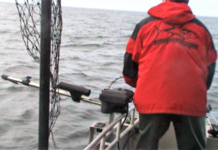
A diver makes his way through Deep Blue Cave, Walsingham System, Bermuda. Image courtesy of Jill Heinerth, Bermuda Deep Water Caves 2011 Exploration, NOAA-OER.
Did You Know?
Studying underwater caves in Bermuda can give us clues about how climate and sea level have changed over time. This knowledge can, in turn, help us better understand and respond to current climate and sea level fluctuations.
When discussing mineral formations in caves, we often talk about stalactites and stalagmites. A stalactite is an icicle-shaped formation that hangs from the ceiling of a cave, and is produced by precipitation of minerals from water dripping through the cave ceiling. Most stalactites have pointed tips.
A stalagmite is an upward-growing mound of mineral deposits that have precipitated from water dripping onto the floor of a cave. Most stalagmites have rounded or flattened tips.
There are many other types of mineral formations found in caves. For example, flowstones are deposits of minerals from water flowing over the floor or walls of a cave. As layers of flowstone become thicker, their shape becomes rounded. Well-defined crystals growing underwater in cave pools are known as pool spar.
Some deposits are named based on their appearance, such as a showerhead, which is a hollow cone-shaped formation, narrow above and broad below. Showerheads are generally only found in tropical caves. A conulite is a “splash cup” that forms when water dripping rapidly through the cave ceiling flings aside loose particles on the cave floor. And the list goes on.
For More Information:
Bermuda Deep Water Caves 2011: Dives of Discovery Expedition Education Module, Bermuda Deep Water Caves 2011: Dives of Discovery
Lesson Plans for Bermuda: Search for Deep Water Caves 2009 Expedition, Bermuda: Search for Deep Water Caves 2009
What is a Karst? (pdf, 299 kb; from the Submerged New World 2009 Expedition)
Sign up for the Ocean Explorer E-mail Update List.














